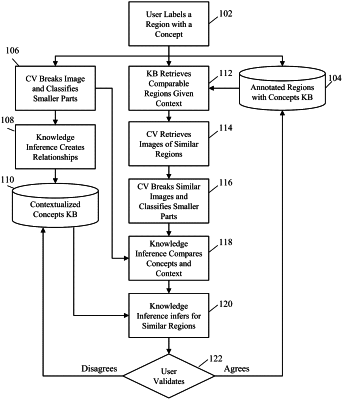| CPC G06N 20/00 (2019.01) [G06F 18/2178 (2023.01); G06F 18/22 (2023.01); G06N 5/04 (2013.01); G06T 7/11 (2017.01)] | 19 Claims |

|
1. A computer-implemented method comprising:
receiving a user annotated concept for a given image in given context;
decomposing the given image into parts;
classifying the parts;
creating relationships among the parts and between the parts and the given context;
storing at least the relationships with the user annotated concept in a knowledge base;
retrieving a second image associated the given context;
decomposing the second image into parts;
classifying the second image's parts;
determining relationships among the second image's parts and between the second image's parts and the given context;
comparing classifications of the second image's parts, the relationships among the second image's parts and between the second image's parts and the given context, with classifications of the given image's parts, the relationships among the given image's parts and between the given image's parts and the given context; and
based on the comparing and responsive to determining that the created relationships associated with the given image and the determined relationships associated with the second image are similar based on a similarity threshold, annotating the second image with the user annotated concept for the given image.
|